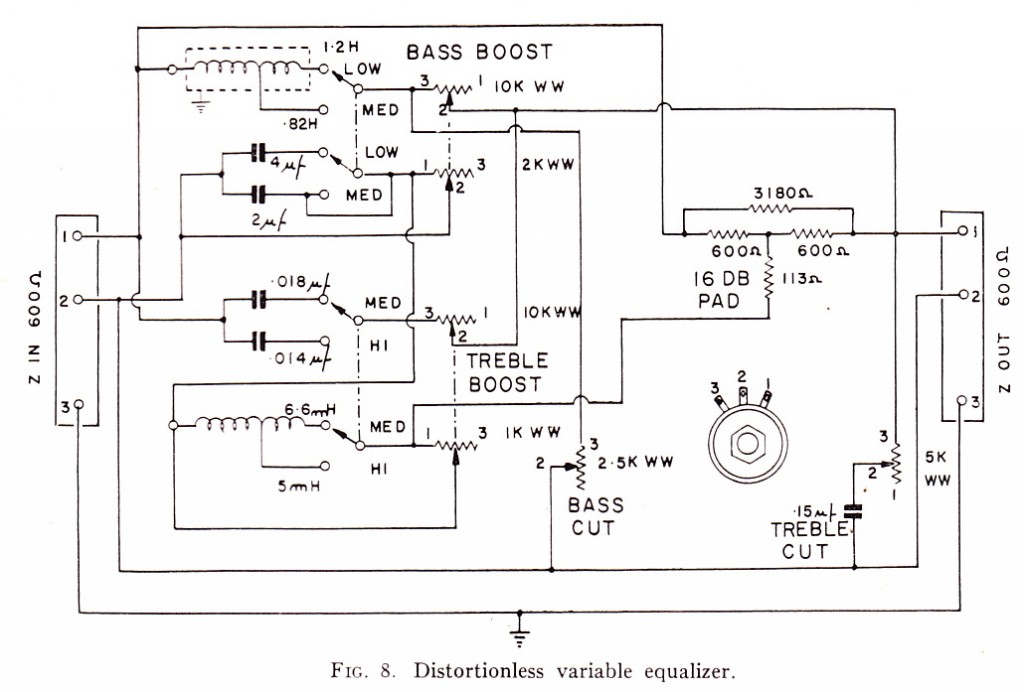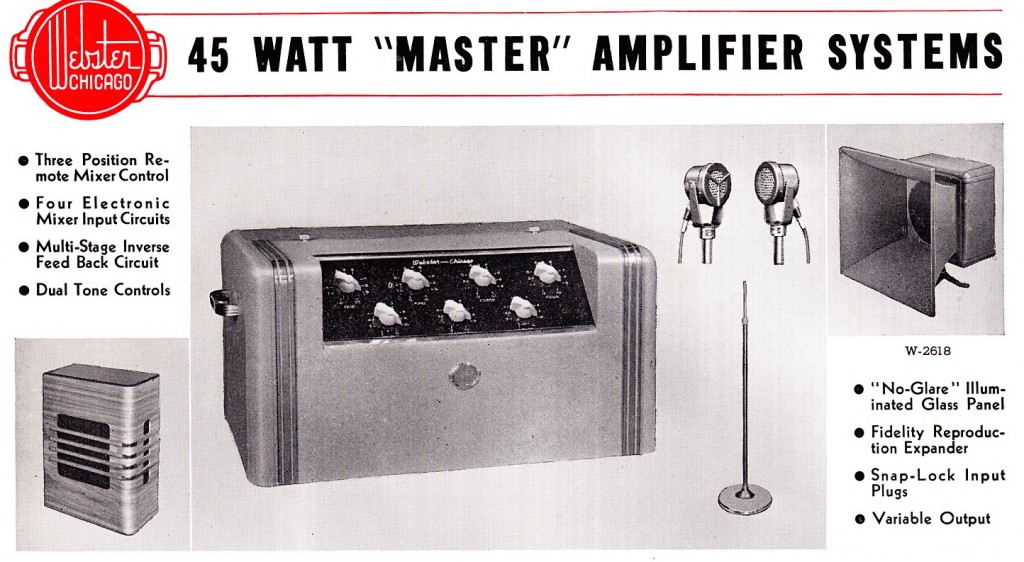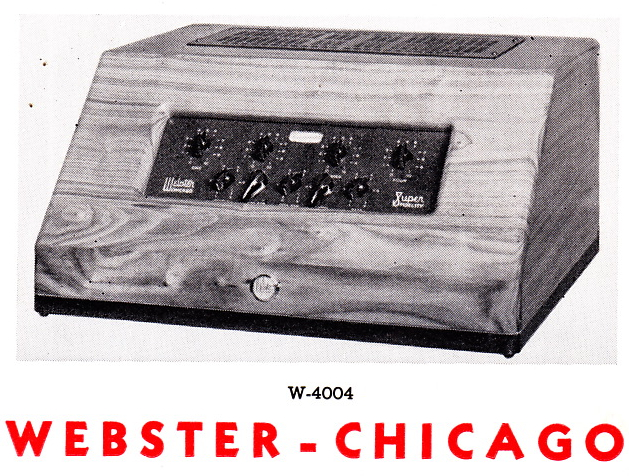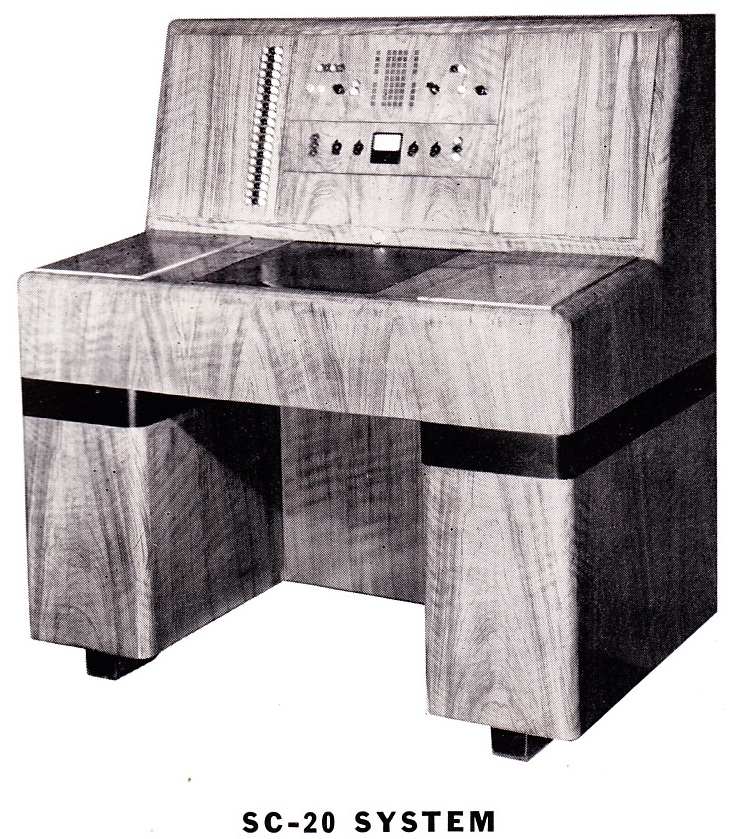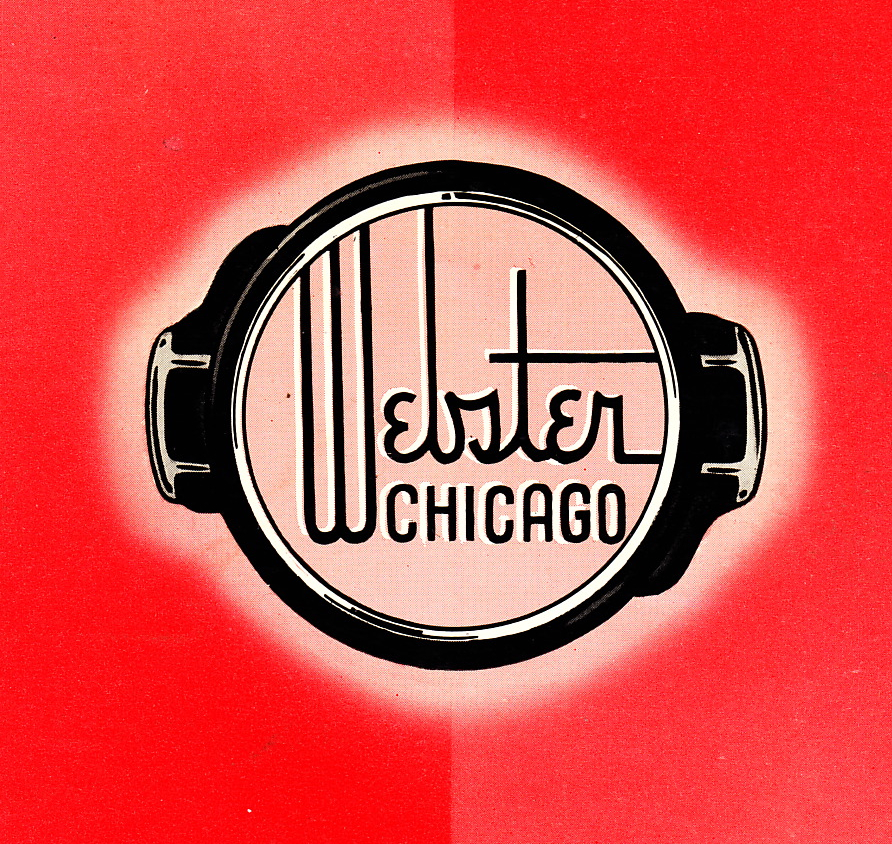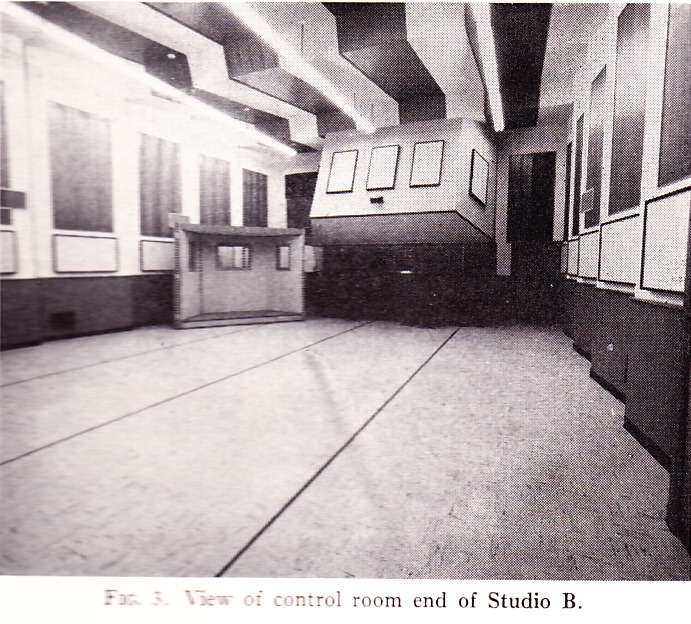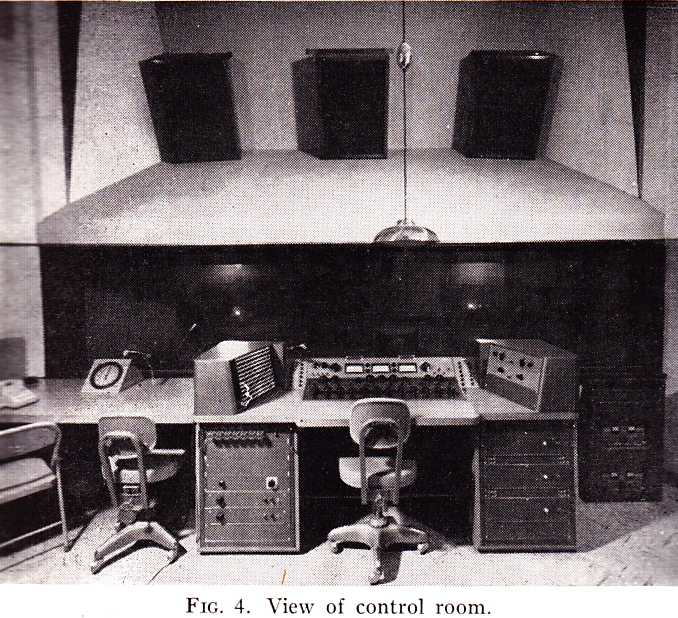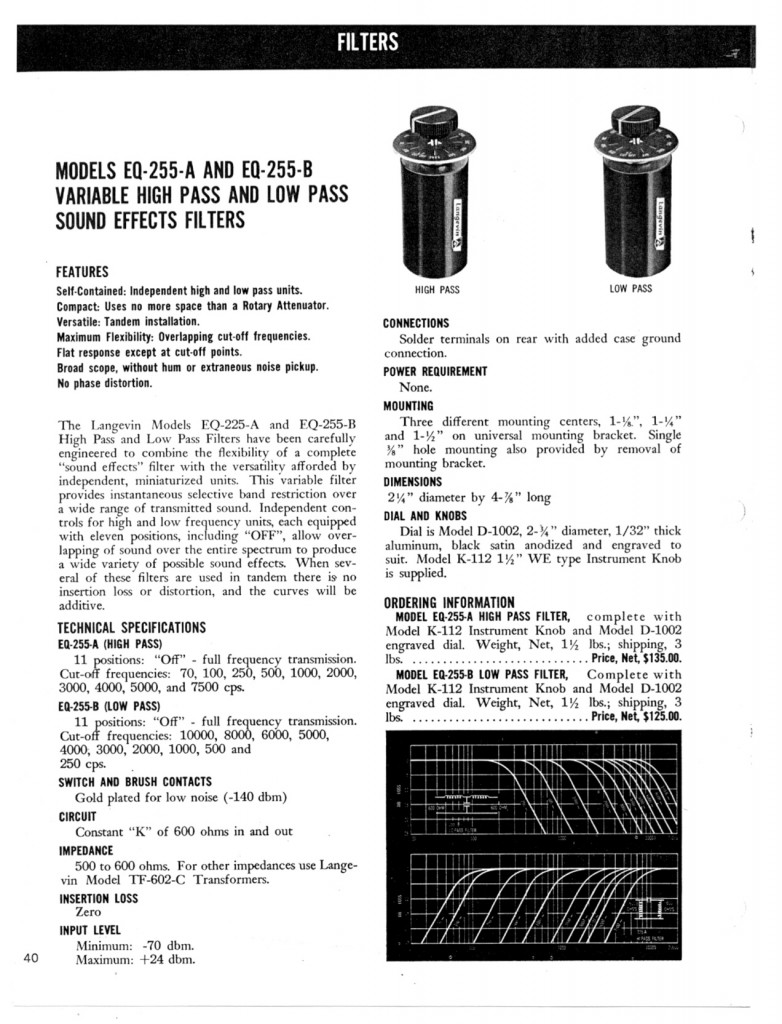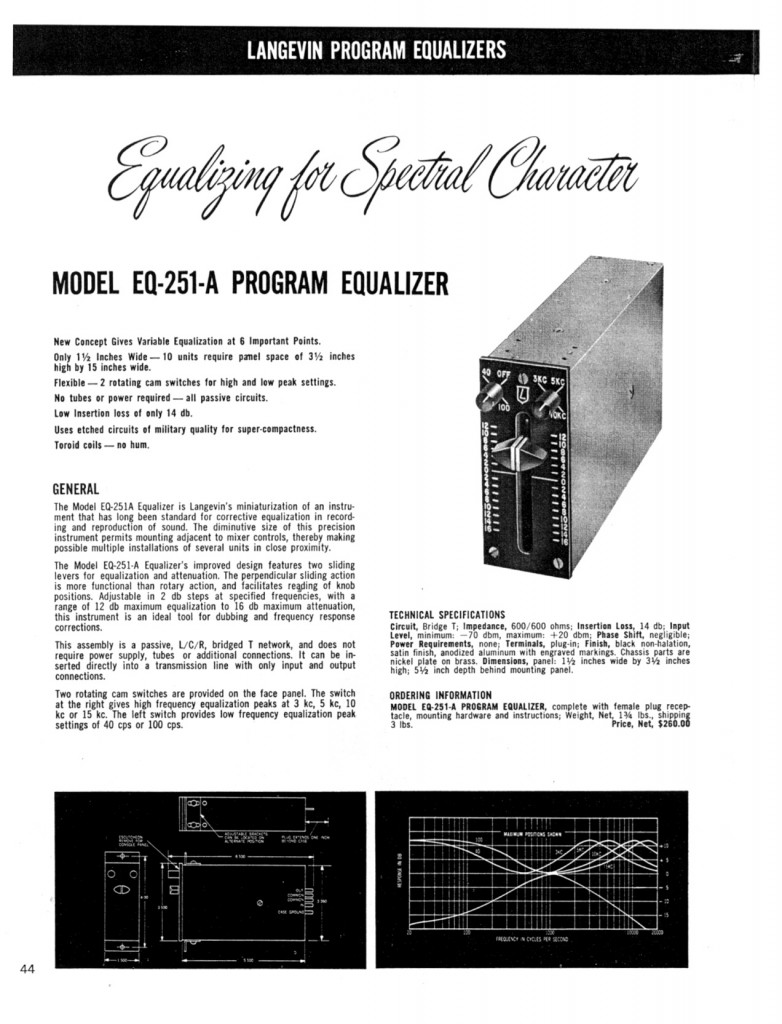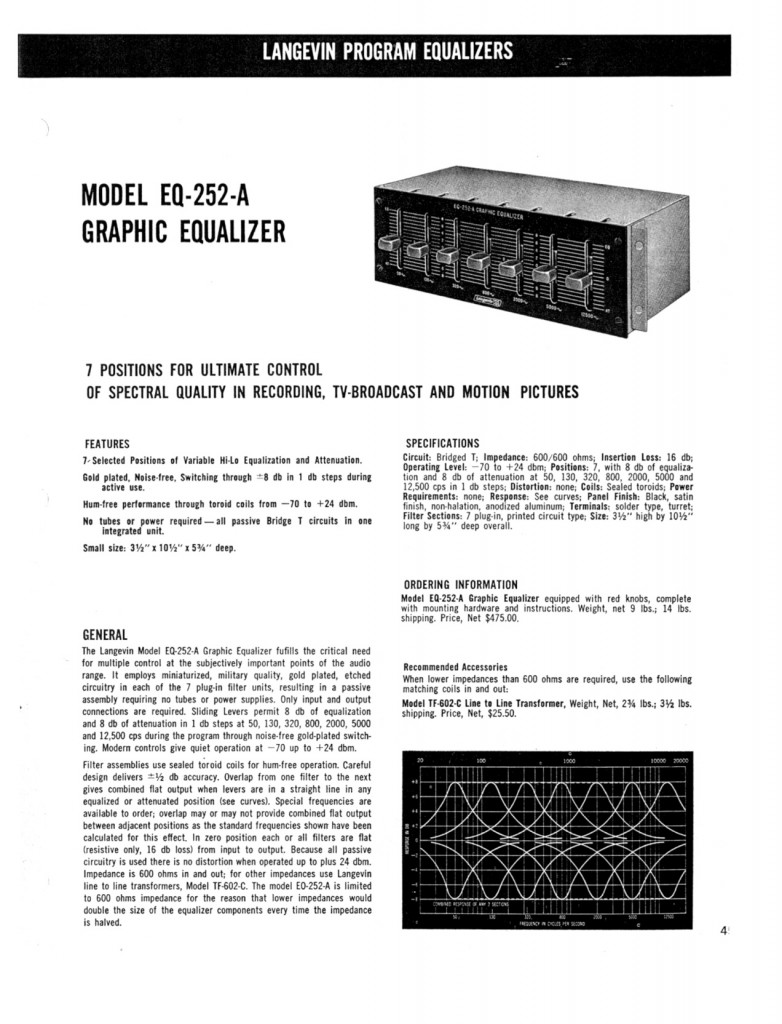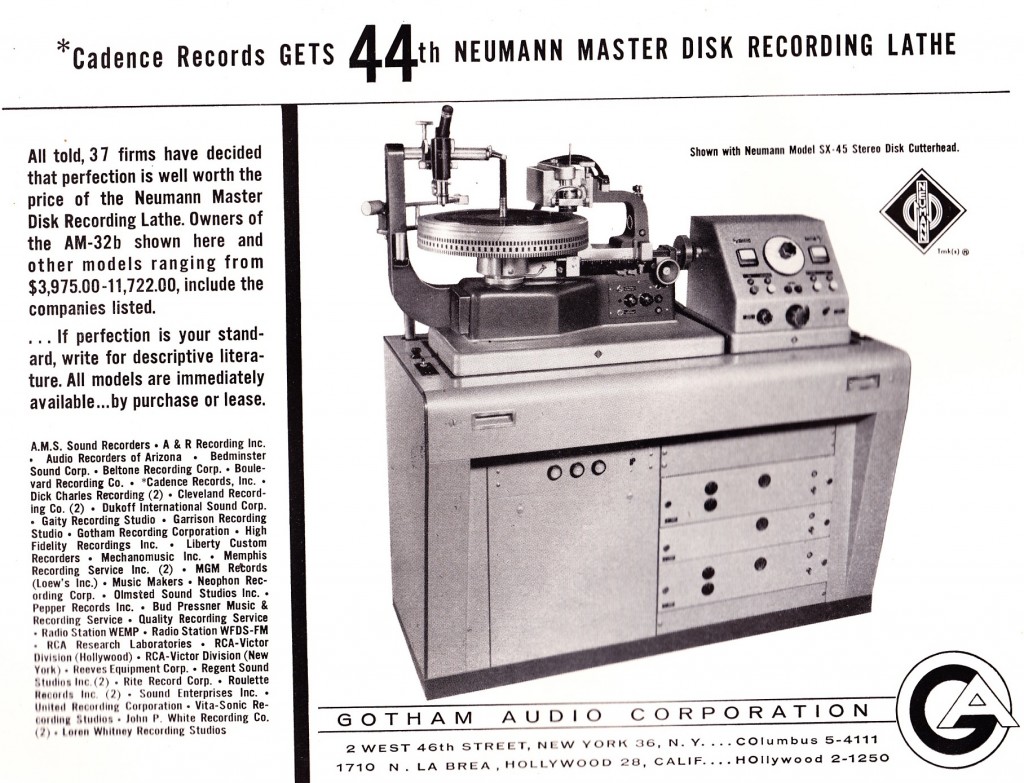 Although Scully seems to have dominated the US lathe market in the 1950s and 1960s, every time I have personally attended an LP mastering session (maybe a dozen times), I have seen a Neumann used. Any of you LP mastering folk prefer Scully brand to Neumann these days?
Although Scully seems to have dominated the US lathe market in the 1950s and 1960s, every time I have personally attended an LP mastering session (maybe a dozen times), I have seen a Neumann used. Any of you LP mastering folk prefer Scully brand to Neumann these days?
Author: chris
Interesting Passive EQ circa 1961
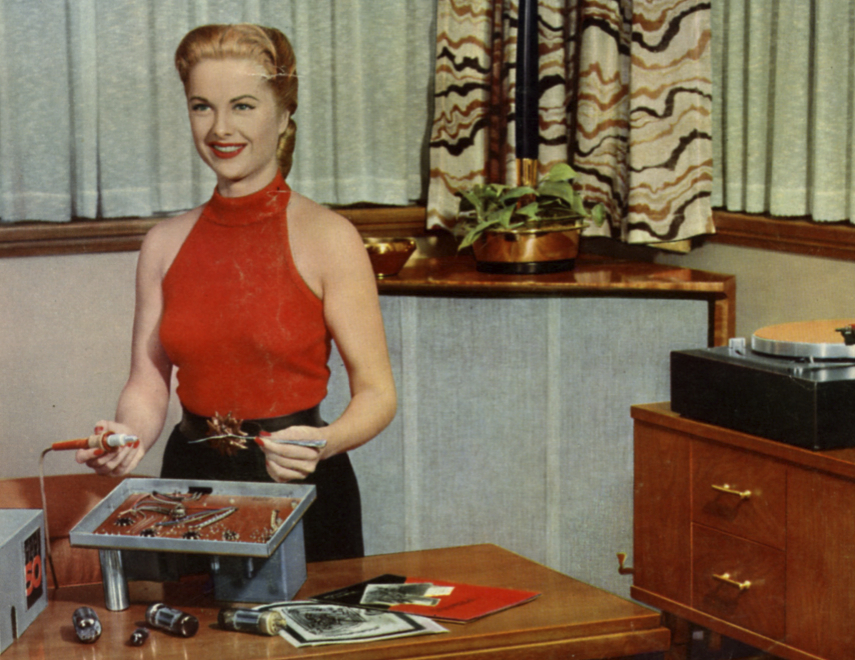 Download a two-page scan of Radio & Television News, August 1957, featuring screen-star Martha Hyer and her DIY audio-hobby.
Download a two-page scan of Radio & Television News, August 1957, featuring screen-star Martha Hyer and her DIY audio-hobby.
DOWNLOAD: Martha Hyer 1957 Radio TV News
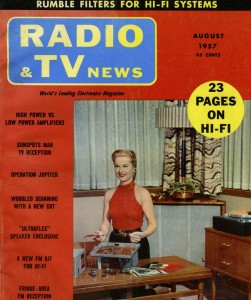 Hyer is shown above in the midst of assembling her PERI 50, a mono hi-fi amp of the late 50s. You can download the schematic for the PERI 50 here: DOWNLOAD PERI 50 SCHEM. It’s a 50-watt ultralinear amp of extremely simple, efficient design.
Hyer is shown above in the midst of assembling her PERI 50, a mono hi-fi amp of the late 50s. You can download the schematic for the PERI 50 here: DOWNLOAD PERI 50 SCHEM. It’s a 50-watt ultralinear amp of extremely simple, efficient design.
Thanks to PS dot com reader T.F. for providing this article. This piece comes as contrast to typical Women-In-Fifties-HiFi depiction, examples of which are in this series of images. Despite the fact that ‘soldering-your-own-amplifier’ falls much closer to the wine-rack rather than gun-rack end of the macho spectrum, there was apparently nothing in American culture of the 50’s that could not be bro-ified, as this charming shop-apron of the era makes apparent:
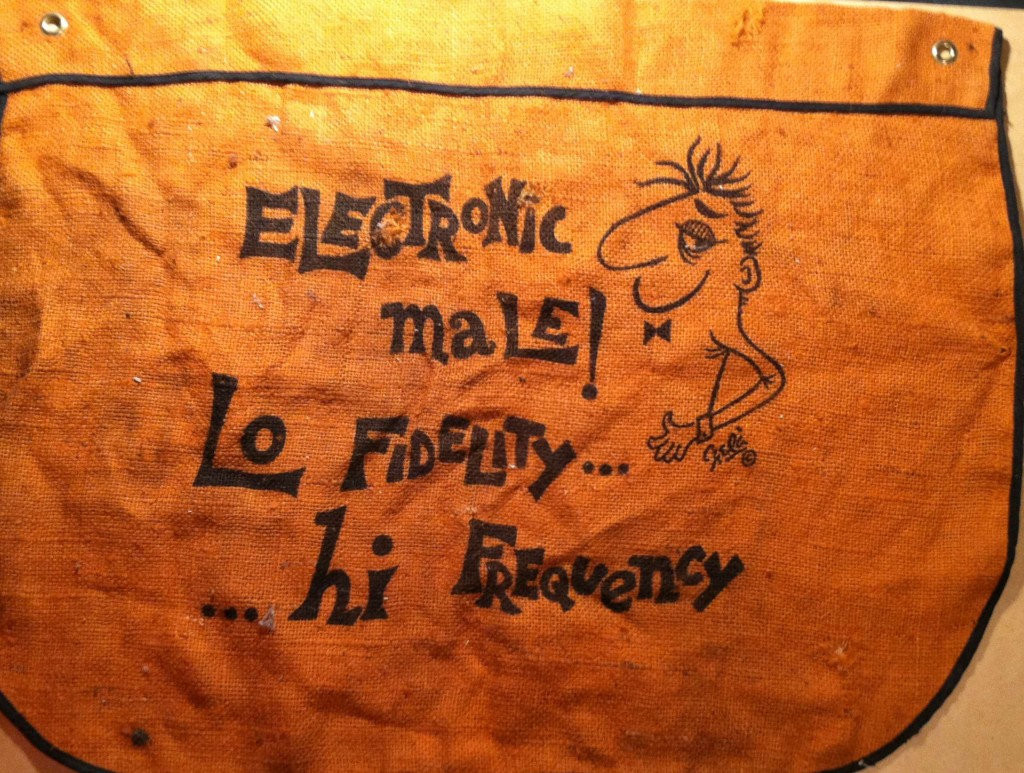 Despite its intended message of unapologetic philandering and stamina, I kinda of get the impression that dude’s workmanship is shoddy and he has a shrill voice. Maybe not the best image to project. Thank god for social progress. And on that note: does this website have any female readers who build/service audio equipment? Drop us a line and represent…
Despite its intended message of unapologetic philandering and stamina, I kinda of get the impression that dude’s workmanship is shoddy and he has a shrill voice. Maybe not the best image to project. Thank god for social progress. And on that note: does this website have any female readers who build/service audio equipment? Drop us a line and represent…
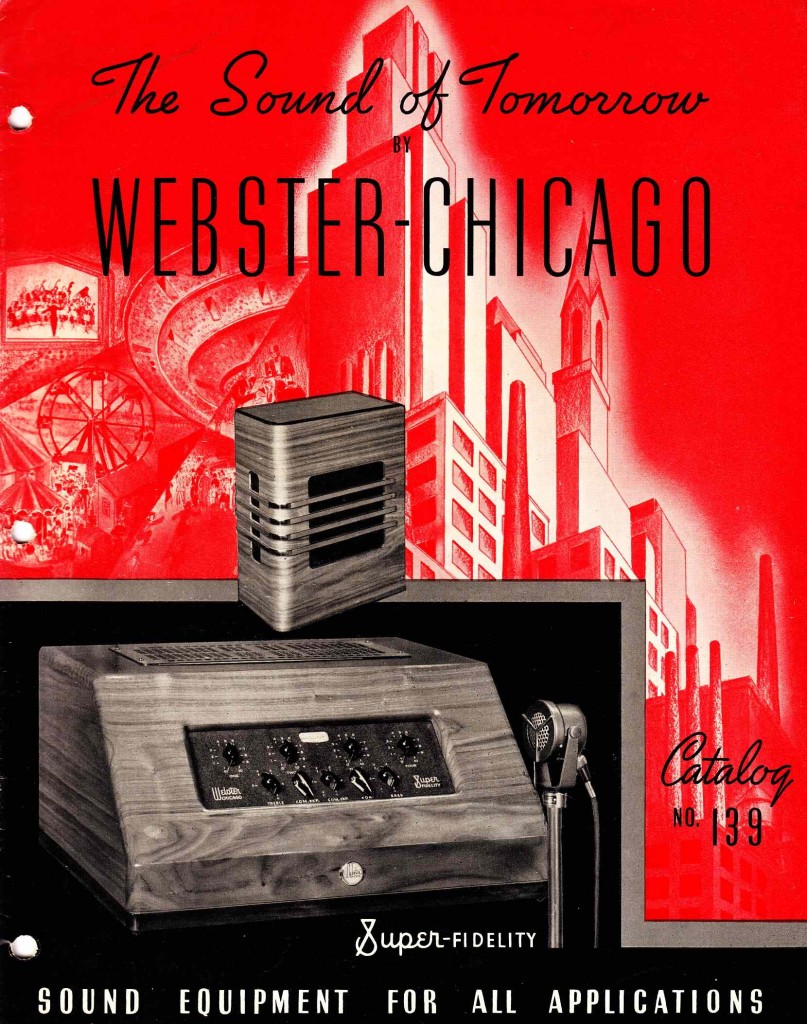 Download the 24pp 1939 Webster-Chicago Sound Systems catalog (in two parts due to size)
Download the 24pp 1939 Webster-Chicago Sound Systems catalog (in two parts due to size)
DOWNLOAD PART 1: WebsterChic_1939_1
DOWNLOAD PART 2: WebsterChic_1939_2
Products covered, with text, specs, and photos, include: Wesbter-Chicago Super-Fidelity Mixer W-4004, amplifiers W-4030, W-4070, W-4030; remote mixer controls W-903 and W-902; W-975, W-945, W-930 .W-920, W-830, W-814, W-808W-929, W-820 mixer/ amplifers; W-200 microphone matching transformer, W-1260 record changer, plus a host of speakers, intercom equipment, and microphones (appear to be re-branded Bruno, Turner, and EV units: W-1224, W-1245, W-1236, W-1242 and W-1243).
 Above: from page 2 of the catalog. The year is 1939. “Why Buy Sound Equipment? Because shouting is outmoded.” The ‘sound of tomorrow’ is electrically amplified sound. Shouting is a thing of the past. The sound of one human’s voice can now easily reach many tens of thousands of assembled individuals. The first recorded use of sound reinforcement (i.e., a PA system) was the inauguration of Warren G. Harding in 1922 (Bushnell, Ferree 2011). This was incredible technology at the time, technology that has given musicians infinite new possibilities for performnce. Technology that would also be used to devastating effect in Germany in the 1930s when one bitter man would be able to stir the passions of thousand of assembled individuals in ways that would have been impossible a mere decade early. Before the PA system: before electrically amplified sound: there were real physical limits to the dissemination of a vocal performance. That limit is no longer.
Above: from page 2 of the catalog. The year is 1939. “Why Buy Sound Equipment? Because shouting is outmoded.” The ‘sound of tomorrow’ is electrically amplified sound. Shouting is a thing of the past. The sound of one human’s voice can now easily reach many tens of thousands of assembled individuals. The first recorded use of sound reinforcement (i.e., a PA system) was the inauguration of Warren G. Harding in 1922 (Bushnell, Ferree 2011). This was incredible technology at the time, technology that has given musicians infinite new possibilities for performnce. Technology that would also be used to devastating effect in Germany in the 1930s when one bitter man would be able to stir the passions of thousand of assembled individuals in ways that would have been impossible a mere decade early. Before the PA system: before electrically amplified sound: there were real physical limits to the dissemination of a vocal performance. That limit is no longer.
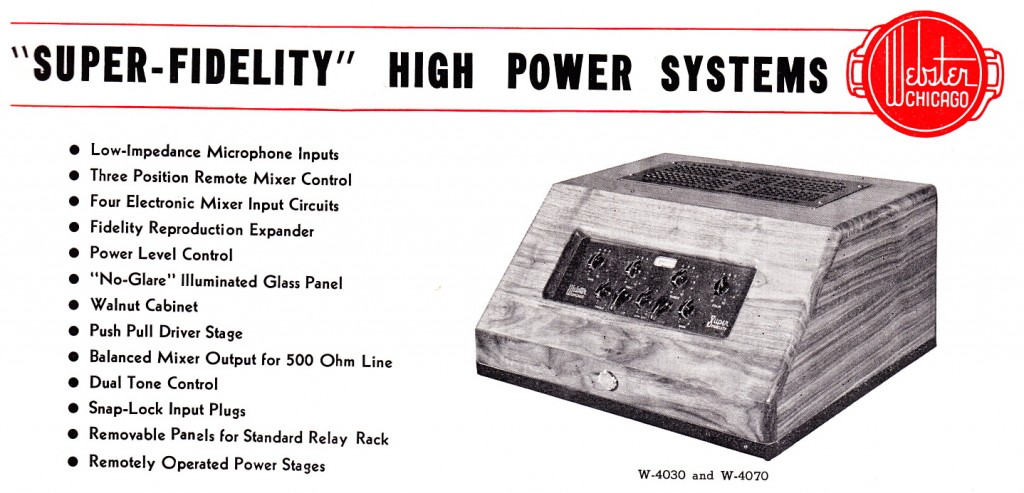 Above, Webster’s ‘super-fidelity’ high-power system intended for multi-speaker distribution in arenas ETC: no low-impedance voice-coil output is even offered on this unit. It does, however, offer two-band EQ and dynamic expansion/compression.
Above, Webster’s ‘super-fidelity’ high-power system intended for multi-speaker distribution in arenas ETC: no low-impedance voice-coil output is even offered on this unit. It does, however, offer two-band EQ and dynamic expansion/compression.
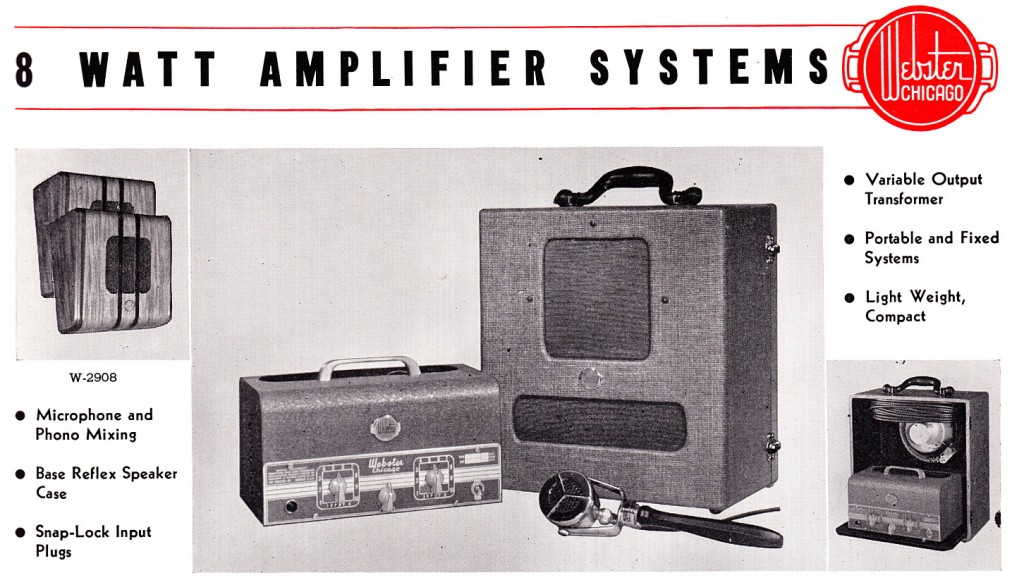 Above, Webster-Chicago’s most modest PA system, the 8-watt W-808. This was the first piece of antique audio equipment that I ever purchased: $75 at a multi-dealer antique shop on Wickenden st in Providence RI. My system came with an American D-4 dynamic mic, which I still own and which still works fine after all these decades. The amplifier and speaker worked too, although I could never figure out why there was a strong slightly off Bb bass-note that went along with everything that I played. This was several years before I had any awareness of filter caps, of course.
Above, Webster-Chicago’s most modest PA system, the 8-watt W-808. This was the first piece of antique audio equipment that I ever purchased: $75 at a multi-dealer antique shop on Wickenden st in Providence RI. My system came with an American D-4 dynamic mic, which I still own and which still works fine after all these decades. The amplifier and speaker worked too, although I could never figure out why there was a strong slightly off Bb bass-note that went along with everything that I played. This was several years before I had any awareness of filter caps, of course.
Many of my regular readers will be familiar with the Shure Level-Loc. For those unfamiliar, the basics: the Level-Loc is a brickwall limiter made by the Shure microphone company for public-address-system use (podium mics, specifically) in the 1960s. It uses discrete transistors and transformers in the signal path; it offers balanced mic-level i/o and an unbalanced consumer-level 10K ohm impedance output as well. There is an input-level control (simply a pot that follows that secondary of the input transformer) and a switch marked ‘distance selector,’ which seems to me to be a threshold control. That’s it for control. It is fairly noisy (full-bandwidth noise), even after a recap, and the transformers are not especially well-shielded. It runs off of a 9V battery. For more information on the Level-Loc, you might want to start here.
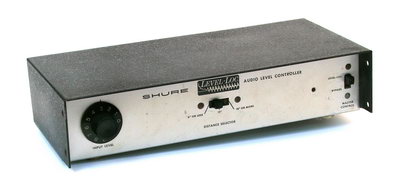 Anyhow…seems like a toy/piece-of-junk and maybe it is, but these things have become highly coveted for use in recording rock drum performances. How much so? Well, how many other prosumer PA-system pieces are currently available as a plug-in, an API-500 series module, and a boutique re-build? (image source for above)
Anyhow…seems like a toy/piece-of-junk and maybe it is, but these things have become highly coveted for use in recording rock drum performances. How much so? Well, how many other prosumer PA-system pieces are currently available as a plug-in, an API-500 series module, and a boutique re-build? (image source for above)
I recently picked up a clean Shure Level-Loc for a few dollars at a yard sale; after the aforementioned re-cap (and we’re talking about 20 capacitors here…), it was sounding like it was probably operating within its original design parameters. I was intrigued, and figured it might be worth getting it into the racks at Gold Coast Recorders to see what it could do. GCR is a big, live-sounding room, so there’s plenty of sound to get out of it with a squashed compressor. The only potential problem: the Level-Loc offers only mic-level or low-level medium-impedance output. I like to run my mic preamps directly into the Lynx convertors; so for the most direct signal, I would need a bridging amp to bring up the level and lower the impedance of the Level-Loc. It would be nice to have an output level control too, and I wanted the piece to be as physically small as possible so that it could sit directly next to the Level-Loc on a 2RU rack shelf. Here’s what I did to solve all of these problems and fold the Level Loc into the studio alongside all the other outboard mic preamps.
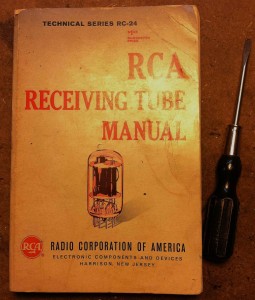
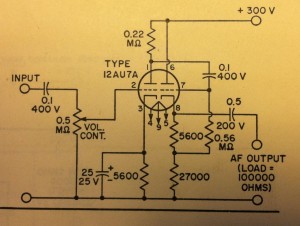 ***********************************************
***********************************************
Most of the RCA Receiving Tube manuals have a schematic for some sort of ‘audio input amplifier’; I wanted one that would provide about 20db of gain as well as a very low-impedance output so that I could drive a 15K:600 output transformer easily (I used an NOS UTC Ouncer to save space). Based on this i selected the circuit above RCA manual # RC-24. One 12AU7 tube. Simple, easy. The physically smallest plate/filament transformer that I had on hand was an NOS Stancor 120v:120V/6.3V, so I used the voltage-doubler B+ supply circuit as-found in the Altec 1566 and 438: here is that schematic via Tangible Technology:
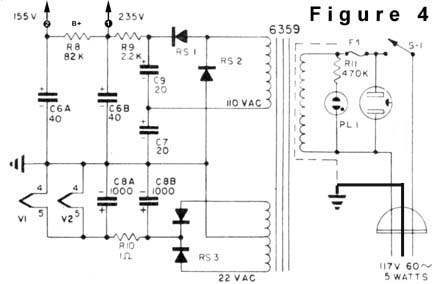 For once i actually did not bother wiring up a DC filament supply, since the gain of the unit is pretty low. This was the right choice, as i can hear no hum at all in the finished unit. I added a 500K pot at the input jack and voila. The whole thing fit inside one of those aluminum Bud Boxes that some folks use for DIY’ing guitar effects pedals. I left the power transformer bolted outside the unit on the rear; it’s always a good idea to keep power transformers away from audio transformers if you can. Here’s the interior of the unit:
For once i actually did not bother wiring up a DC filament supply, since the gain of the unit is pretty low. This was the right choice, as i can hear no hum at all in the finished unit. I added a 500K pot at the input jack and voila. The whole thing fit inside one of those aluminum Bud Boxes that some folks use for DIY’ing guitar effects pedals. I left the power transformer bolted outside the unit on the rear; it’s always a good idea to keep power transformers away from audio transformers if you can. Here’s the interior of the unit:
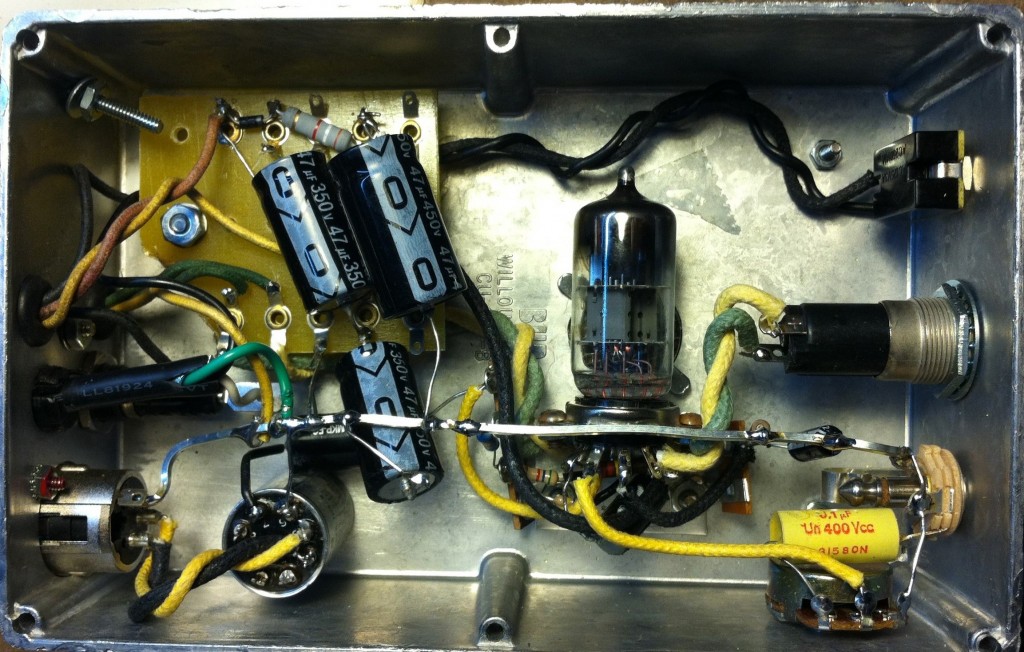 …and below you can see the finished piece. Not my finest piece of industrial design but it does the job. I put the 1/4″ TS input on the front of the unit so that I can use it as a DI input for Keyboards ETC if the need arises. The circular grill on the top surface of the piece is a heat-vent positioned directly above the 12AU7 tube.
…and below you can see the finished piece. Not my finest piece of industrial design but it does the job. I put the 1/4″ TS input on the front of the unit so that I can use it as a DI input for Keyboards ETC if the need arises. The circular grill on the top surface of the piece is a heat-vent positioned directly above the 12AU7 tube.
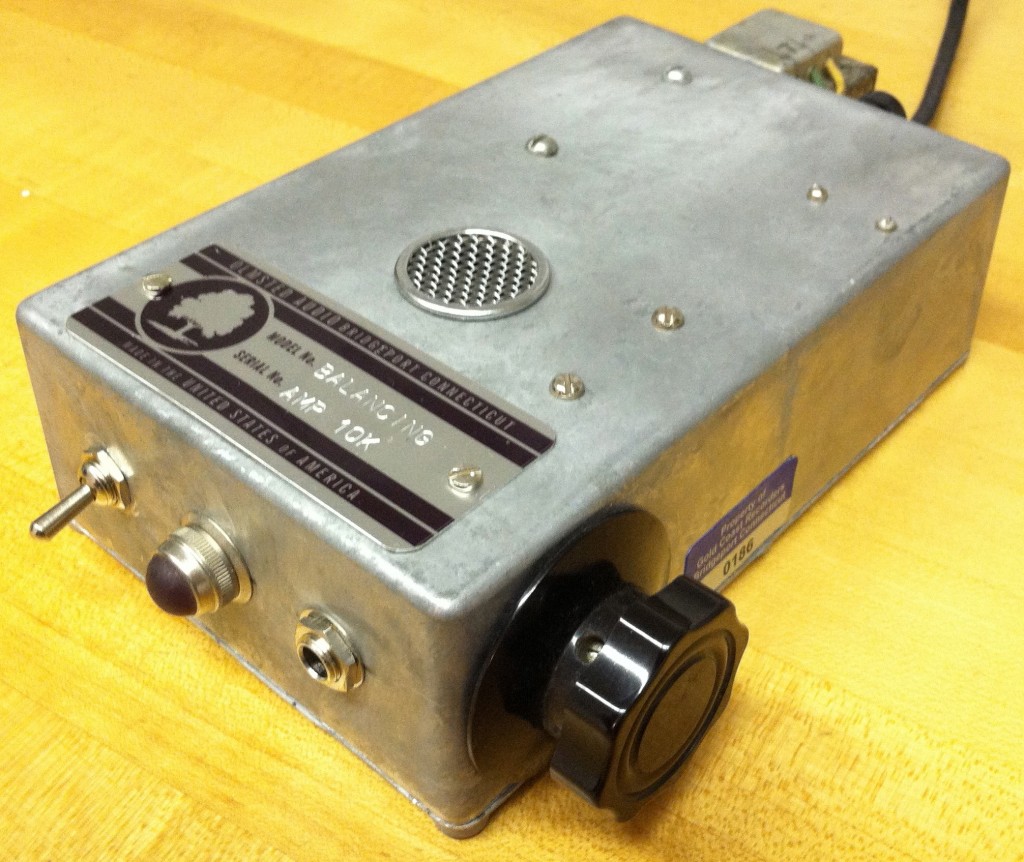 The unit performs well, especially considering that there are only two stages of filtering in the power supply. I always use four stages of filtering in the equipment that I build for customers, with at least one choke; I was curious this time to see how the basic Altec B+ scheme worked, though, and it seems just fine! People love their 1566s and 438s so fukk it. Good enough is sometimes good enough…
The unit performs well, especially considering that there are only two stages of filtering in the power supply. I always use four stages of filtering in the equipment that I build for customers, with at least one choke; I was curious this time to see how the basic Altec B+ scheme worked, though, and it seems just fine! People love their 1566s and 438s so fukk it. Good enough is sometimes good enough…
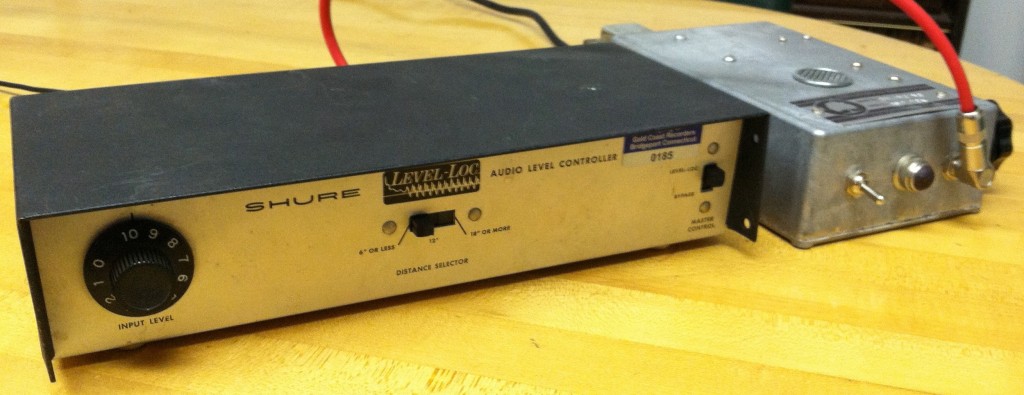 Above, the two units side-by side. So how does it sound? TW and I were putting down live drums on a track at GCR and here’s the result we got.
Above, the two units side-by side. So how does it sound? TW and I were putting down live drums on a track at GCR and here’s the result we got.
First, the drumbeat: close-mics only: CloseOnly
Here’s the same mix, but with the Level Loc signal added: in this case, the Level Loc was amplifying a figure-8 ribbon mic 20 feet from the kit, with the null of the mic facing the kit; the waveform was then re-aligned to eliminate some of the delay: withLevelLoc
And finally, the Level-loc signal only: LevelLocOnly
The Level-Loc is aptly named. Regardless of what you put in – a baby’s breath or an atomic blast – you get the saaaaame level out. Zero dynamics. It’s pretty uncanny. And a great sound for heavy rock drum beats. This is the 2nd track that I have used it on in a week and I think it will continue to get a lot of use at the studio. The output of the balancing amp is a little low – even with the input attenuator all the way open it cannot quite get to full level via the Lynx convertors. It’s good enough, but it could stand to put out a few more DB. If you build one of these devices for use with your Level-loc you might consider using a 15K:60K interstage transformer at the input to get a little bit more level out of it; or re-bias the two stages in order to use a 12AT7 instead of the 12AU7.
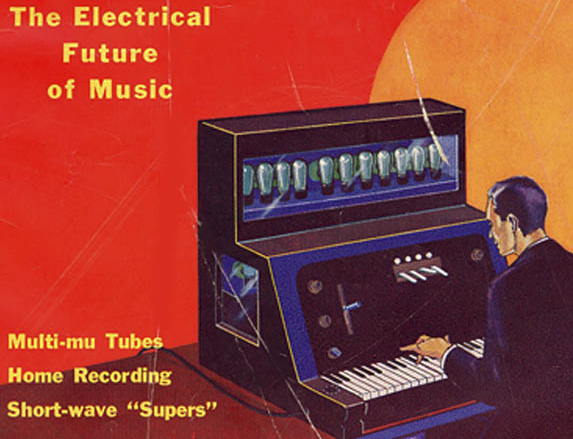 When you think of ‘early electronic instruments,’ what period comes to mind? European tape music of the 1950s? Academic electronic music labs of the 1960s? How about 1931?
When you think of ‘early electronic instruments,’ what period comes to mind? European tape music of the 1950s? Academic electronic music labs of the 1960s? How about 1931?
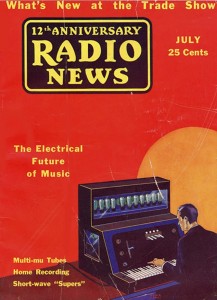 Download a five-page article from Radio News 1931, on ‘The Electrical Future Of Music.’
Download a five-page article from Radio News 1931, on ‘The Electrical Future Of Music.’
DOWNLOAD: Radio_News_3107_Electronic_Music
It’s interesting to see her how the focus is primarily on the creation of instruments on which one could perform western tempered music (as opposed to music concrete or noise-music). Although those more avant garde approaches to electronic music would come soon, this earlier approach – the electronic (as opposed to bellows) organ, the violin-simulating theremin – seems to be what has won out. Eighty years later, most of us are not usually listening to atonal clusters of carefully organized noise – we’re still mostly listened to very diatonic, 4/4 folk-songs (essentially) performed and presented via wholly electronic means.
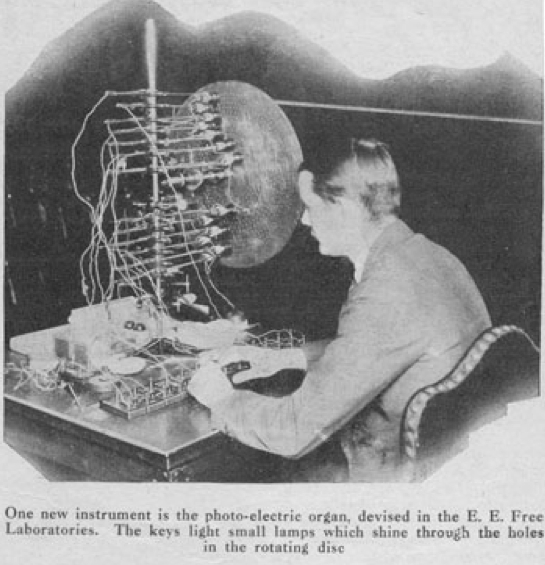
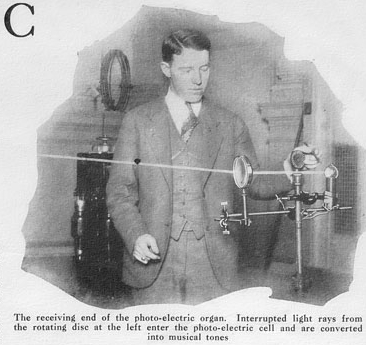 Above: the photo-electric organ
Above: the photo-electric organ
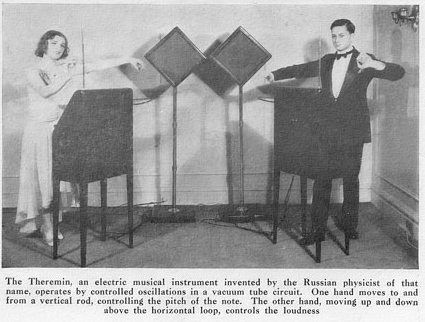 Above: the Theremin, still popular today in a variety of musical genres.
Above: the Theremin, still popular today in a variety of musical genres.
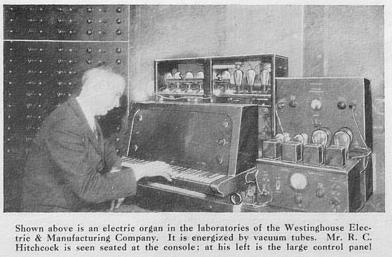 Above: an electronic organ built by Westinghouse, 1931.
Above: an electronic organ built by Westinghouse, 1931.
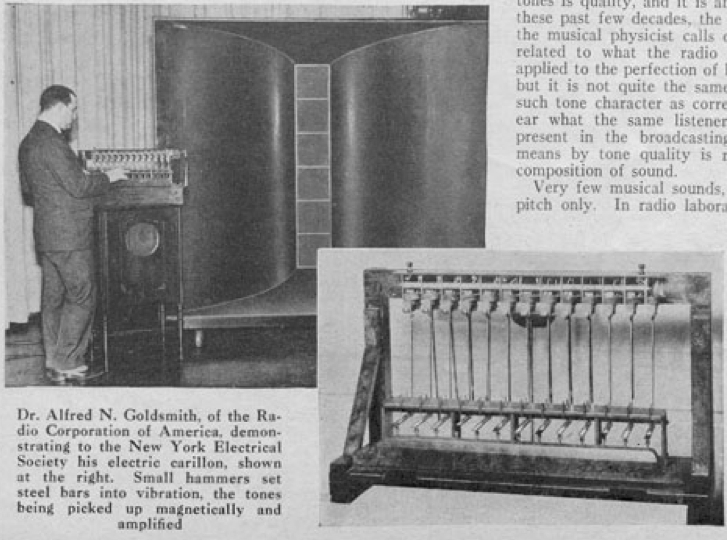 Above: an electronic Carillion as built by RCA. The principle employed here is also still very popular today.
Above: an electronic Carillion as built by RCA. The principle employed here is also still very popular today.
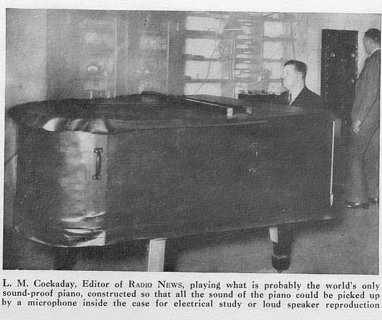 Early attempt at acoustic isolation of an instrument for electronic pickup
Early attempt at acoustic isolation of an instrument for electronic pickup
Communication
 Today: some excerpts from a piece by C.W. Vadersen as published in the AES journal. It’s a good thing to remember that early audio technology developed not out of the entertainment industry but from the communications industry: primarily, the telegraph. As important to us as music and art maybe, the need to communicate is primary (or at least secondary only to the 4 F’s: Feed, Fight, Flight, Sex).
Today: some excerpts from a piece by C.W. Vadersen as published in the AES journal. It’s a good thing to remember that early audio technology developed not out of the entertainment industry but from the communications industry: primarily, the telegraph. As important to us as music and art maybe, the need to communicate is primary (or at least secondary only to the 4 F’s: Feed, Fight, Flight, Sex).
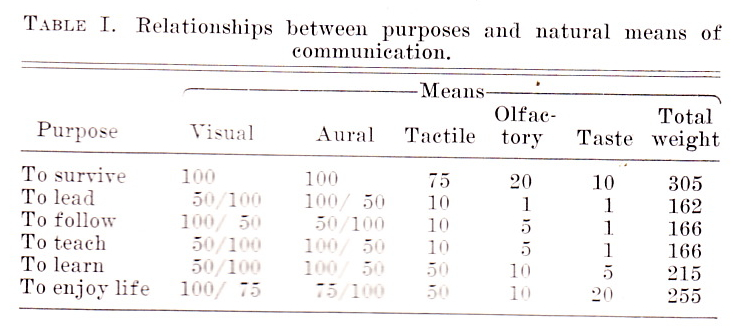 How to we use our senses, and in what proportion? (in Vadersen’s opinon…)
How to we use our senses, and in what proportion? (in Vadersen’s opinon…)
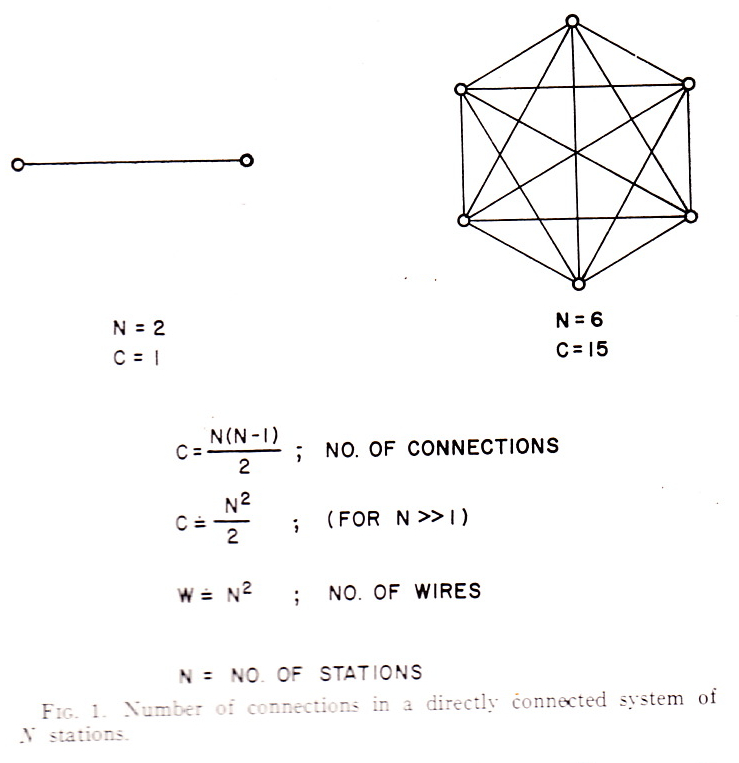 Our interpersonal connections grown exponentially with each new ‘cable’ that we run
Our interpersonal connections grown exponentially with each new ‘cable’ that we run
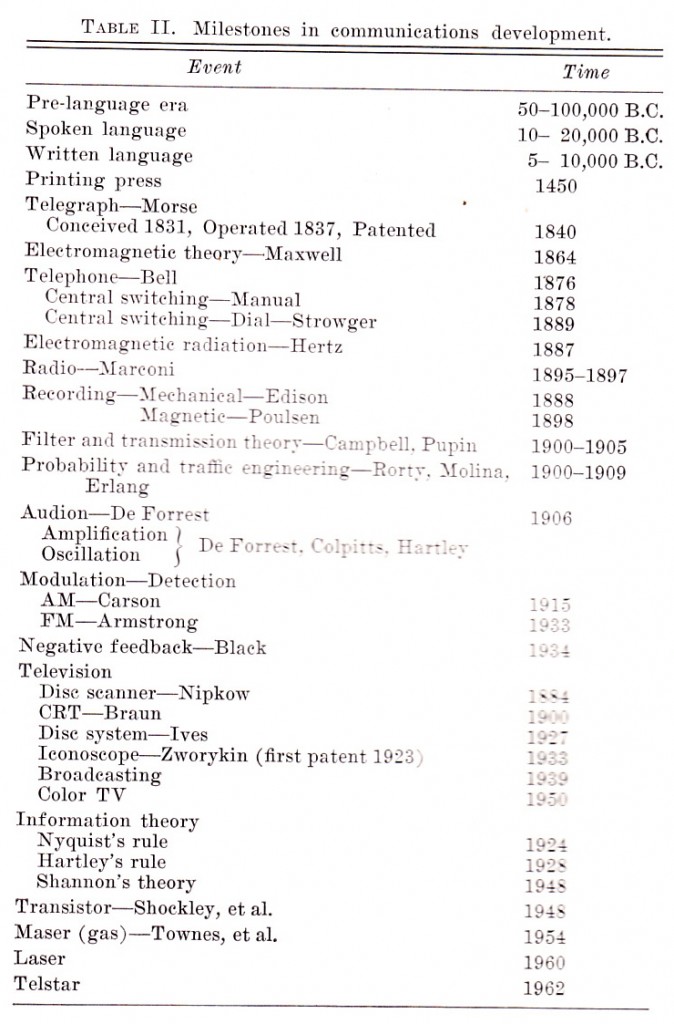 The arc of communications technologies circa 1962. It’s almost impossible to wrap the mind around the growth we’ve seen since then. How far down on this list would ‘Blog’ appear?
The arc of communications technologies circa 1962. It’s almost impossible to wrap the mind around the growth we’ve seen since then. How far down on this list would ‘Blog’ appear?
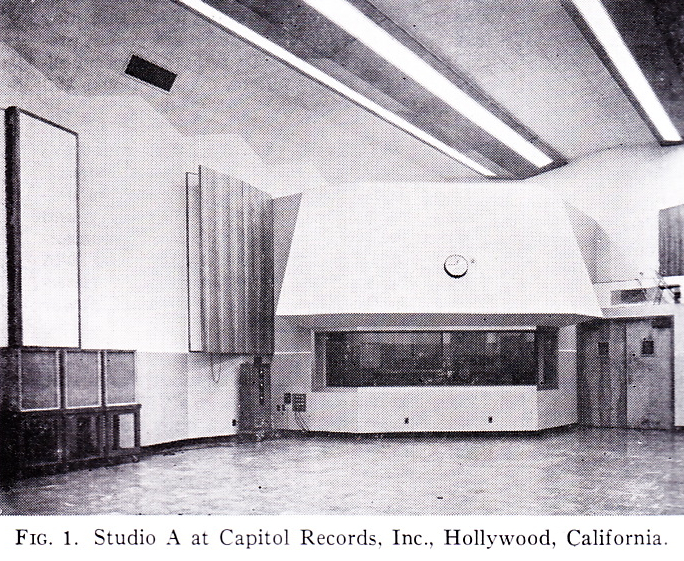
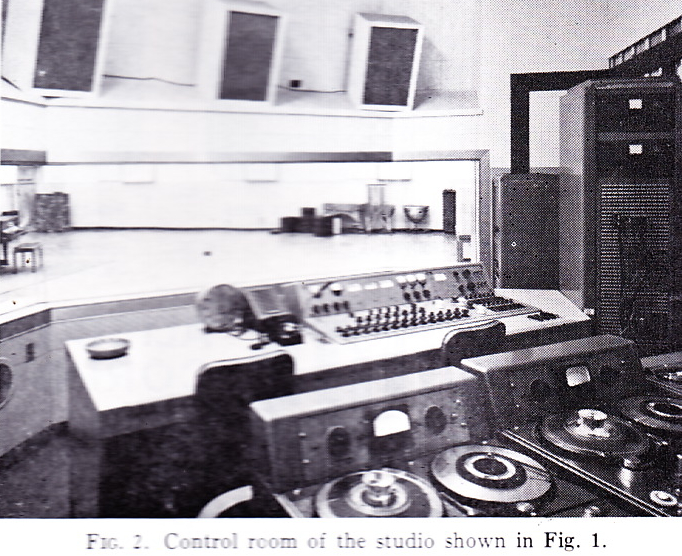 Above: the live room and control room of Capitol A, Los Angeles, circa late 1950’s.
Above: the live room and control room of Capitol A, Los Angeles, circa late 1950’s.

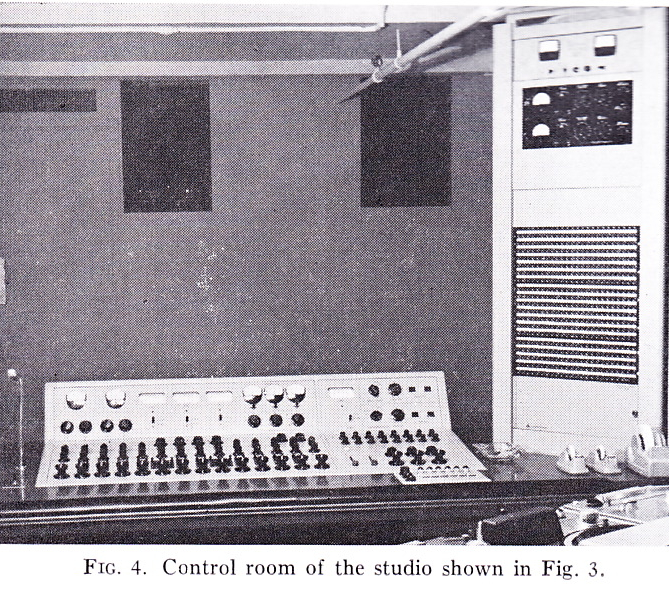
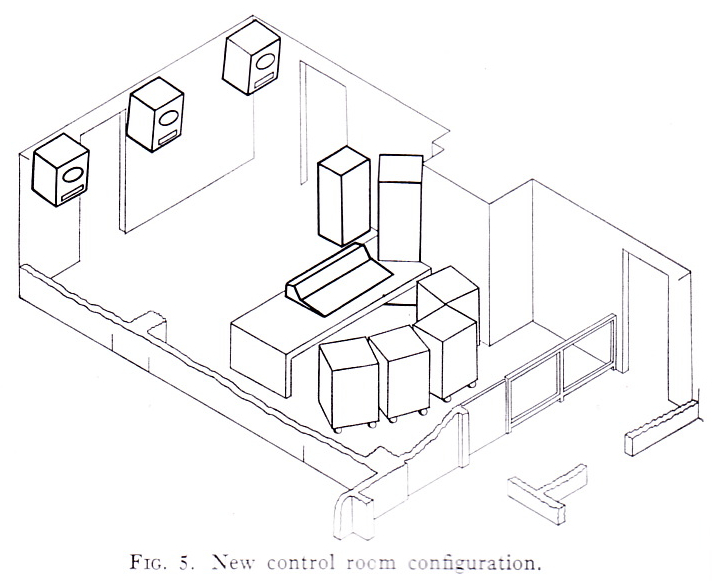 Capitol Records Studio A, New York, 1963.
Capitol Records Studio A, New York, 1963.
Capitol Records, like most big record companies of the fifties and sixties, had their own state-of-the-art recording studios: and on both coasts, no less. I am currently in the process of building a bespoke audio piece for a busy New York studio at the moment. My client is fairly unique (these days) in that they are a very well-equipped, full-scale label studio – a recording studio owned and operated by a record label and used by many of the label’s artists to record and mix their albums. This concept makes sense to me, as I worked for a decade for Sony Music in New York and spent at least half of that time at their enormous studio complex on West 54th street. The label-studio is becoming a thing of the past, but so is the traditional record-label business model. It will be interesting to see what ‘record companies’ evolve into in the next few decades, and whether or not the ‘means of production’ become more or less a part of this new business model.
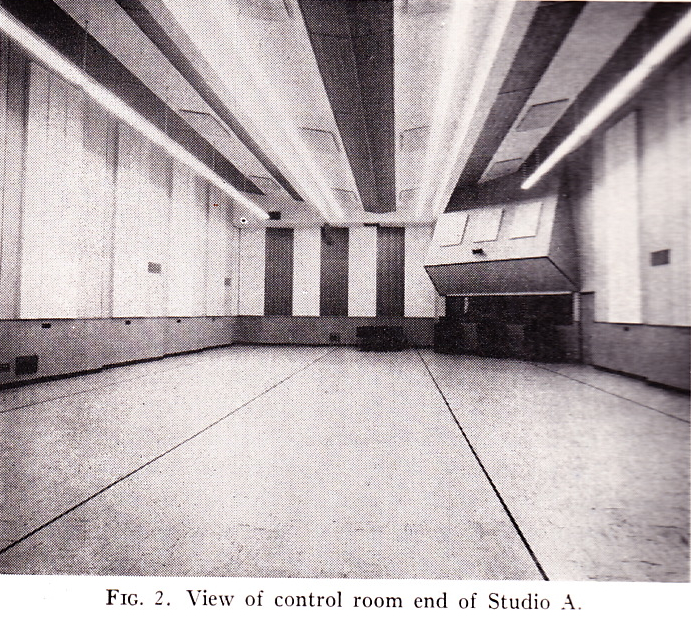 Wow what a titan Bill Putnam was. Not only did the man create some of the greatest audio equipment ever made, equipment that is still coveted and used on major records some 50 years after it was introduced, he also designed and built (and worked in) some of the greatest recording studios ever made (the later of which were bankrolled by Frank Sinatra, among others). It’s almost impossible to think of a similar comparison today… it would be like if the same dude who coded the best plug-ins that you use every day also engineered the hit records that you hear on the radio and also owned the world’s top recording studio, which he designed himself, and which Thom Yorke paid for… anyway… amazing. Here’s the room he built in Hollywood in the late 1950s. Much more information is available all over the ‘net… you can start here…
Wow what a titan Bill Putnam was. Not only did the man create some of the greatest audio equipment ever made, equipment that is still coveted and used on major records some 50 years after it was introduced, he also designed and built (and worked in) some of the greatest recording studios ever made (the later of which were bankrolled by Frank Sinatra, among others). It’s almost impossible to think of a similar comparison today… it would be like if the same dude who coded the best plug-ins that you use every day also engineered the hit records that you hear on the radio and also owned the world’s top recording studio, which he designed himself, and which Thom Yorke paid for… anyway… amazing. Here’s the room he built in Hollywood in the late 1950s. Much more information is available all over the ‘net… you can start here…
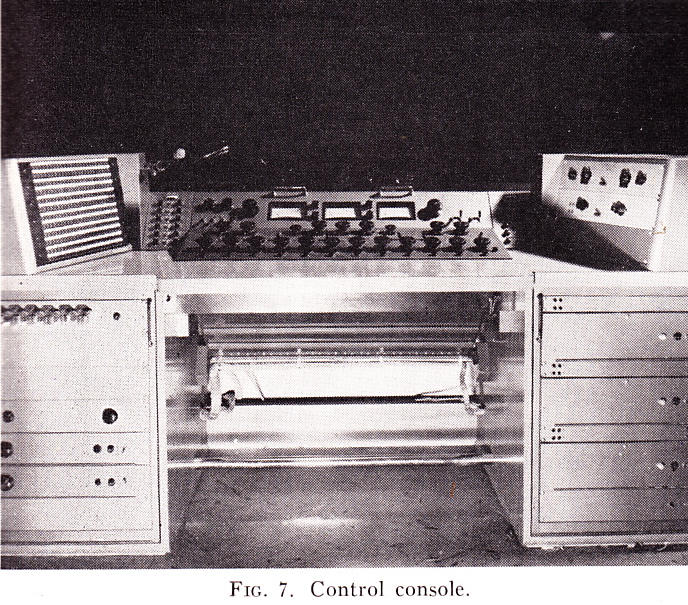
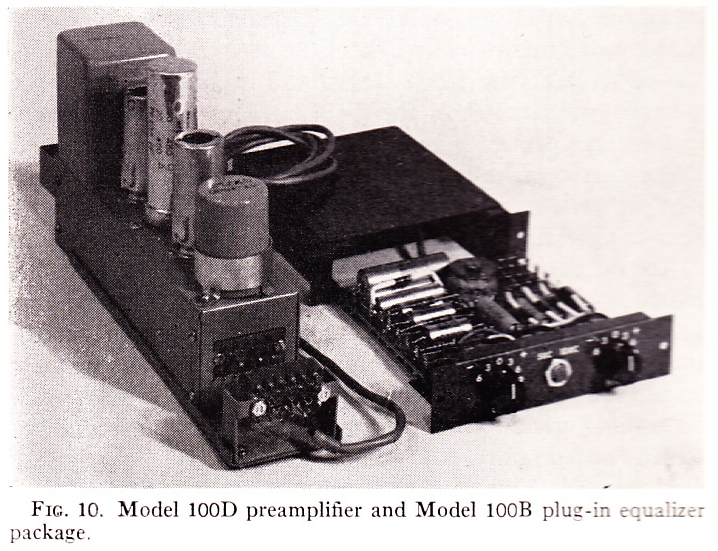 Moving from wide to close-up in these pics above: the studios, the control room, the console, and the console preamps, all designed by Putnam. Okay so yr gonna move to a new town and build a new studio… might as well design all new recording equipment while you are at it. Putnam’s approach has inspired me deeply (on a much smaller scale…) with Gold Coast Recorders and the custom equipment that I’ve developed around my work in that room. Here’s to hoping we have (even a fraction of) his success…
Moving from wide to close-up in these pics above: the studios, the control room, the console, and the console preamps, all designed by Putnam. Okay so yr gonna move to a new town and build a new studio… might as well design all new recording equipment while you are at it. Putnam’s approach has inspired me deeply (on a much smaller scale…) with Gold Coast Recorders and the custom equipment that I’ve developed around my work in that room. Here’s to hoping we have (even a fraction of) his success…
P.S.: David Kulka of Studio Electronics has made twenty issues of the URC company newsletter available for free download on his website. The newsletters span the years 1964-1970 and they are an invaluable resource for anyone interested in ye olde recording studio lore…
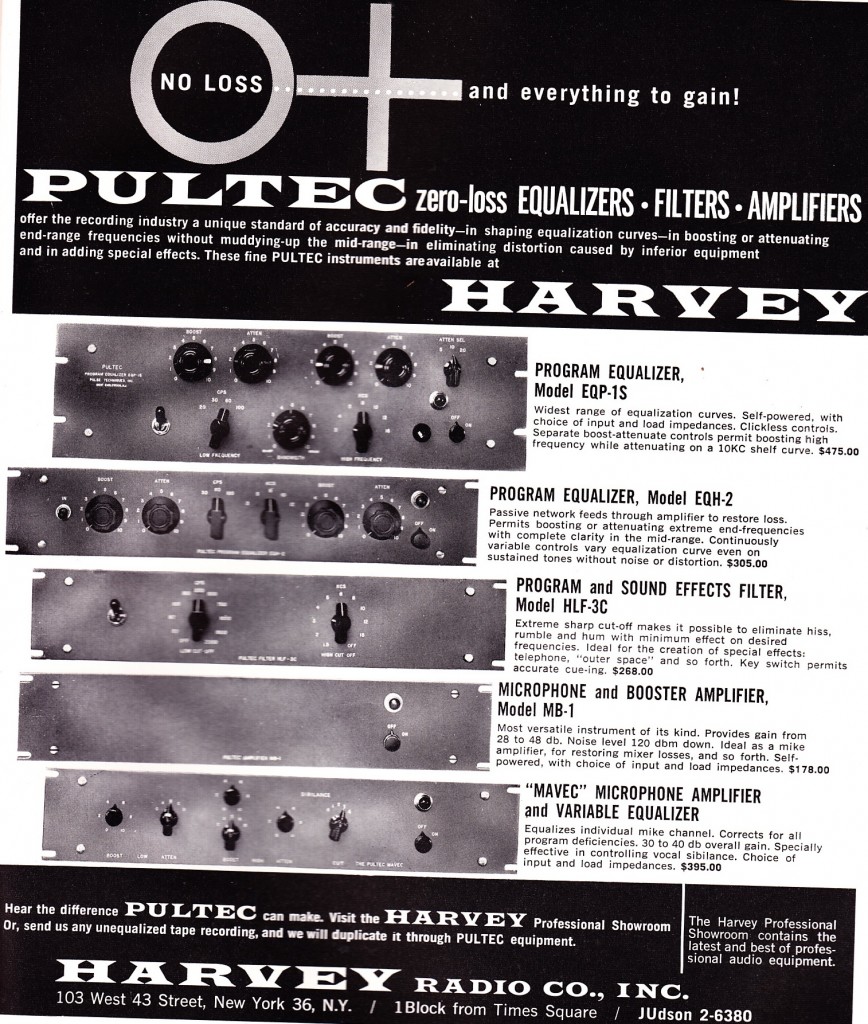 The Pultec range of 1961: the Pultec EQP-1S program equalizer, EQH-2 program equalizer, HLF-3C high and low pass filter set, MB-1 mic and booster amp, and Mavec micpre/EQ unit.
The Pultec range of 1961: the Pultec EQP-1S program equalizer, EQH-2 program equalizer, HLF-3C high and low pass filter set, MB-1 mic and booster amp, and Mavec micpre/EQ unit.
Pultec equalizers have enjoyed fifty-plus years of popularity among recording professionals. Much like the first several compressors released by Universal Audio/UREI, they have never really gone out of style. And if vintage Pultecs seem expensive these days (and they no doubt are…), remember that there is an inflation factor of 11x from 1961 to 2012. So the value of these pieces has more or less simply risen with inflation.
Download catalog data on the EQP 1, shown above: Pultec_EQP-1
Download catalog data on the EQH 2, shown above: Pultec_EQH
Download catalog data on the HLF, shown above: Pultec_HLF-3
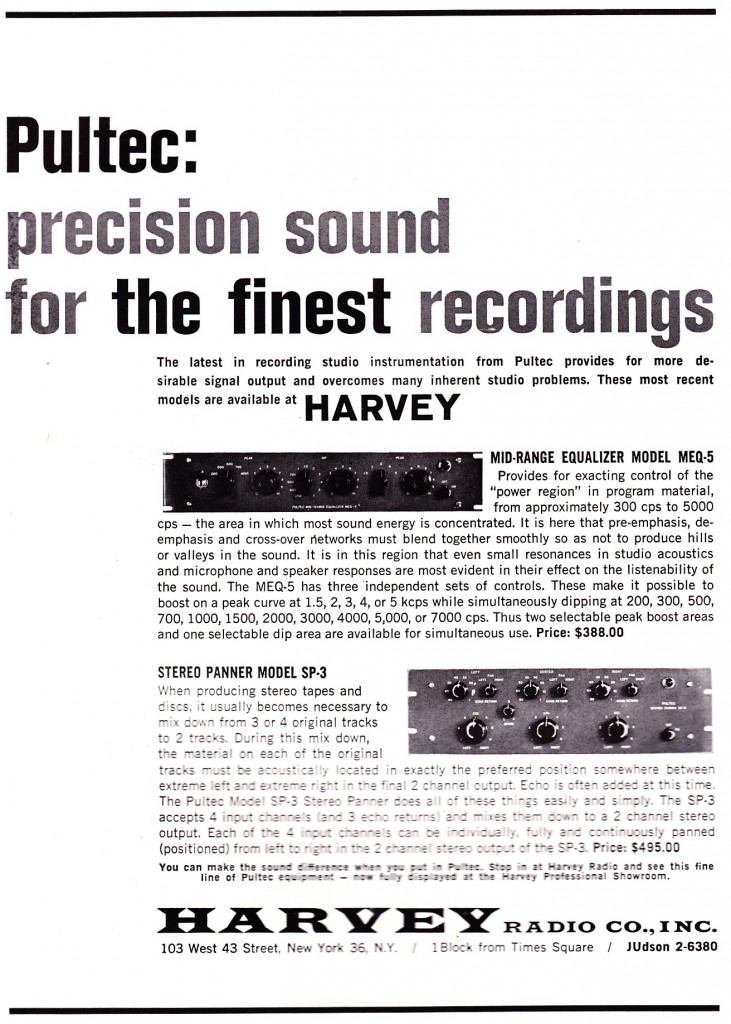 The Pultec MEQ-5 and SP-3 Stereo Panner of 1962. As unlikely as it might seem, the ‘pan’ knob was, at one time, a new and novel concept.
The Pultec MEQ-5 and SP-3 Stereo Panner of 1962. As unlikely as it might seem, the ‘pan’ knob was, at one time, a new and novel concept.
*************
*******
***
*
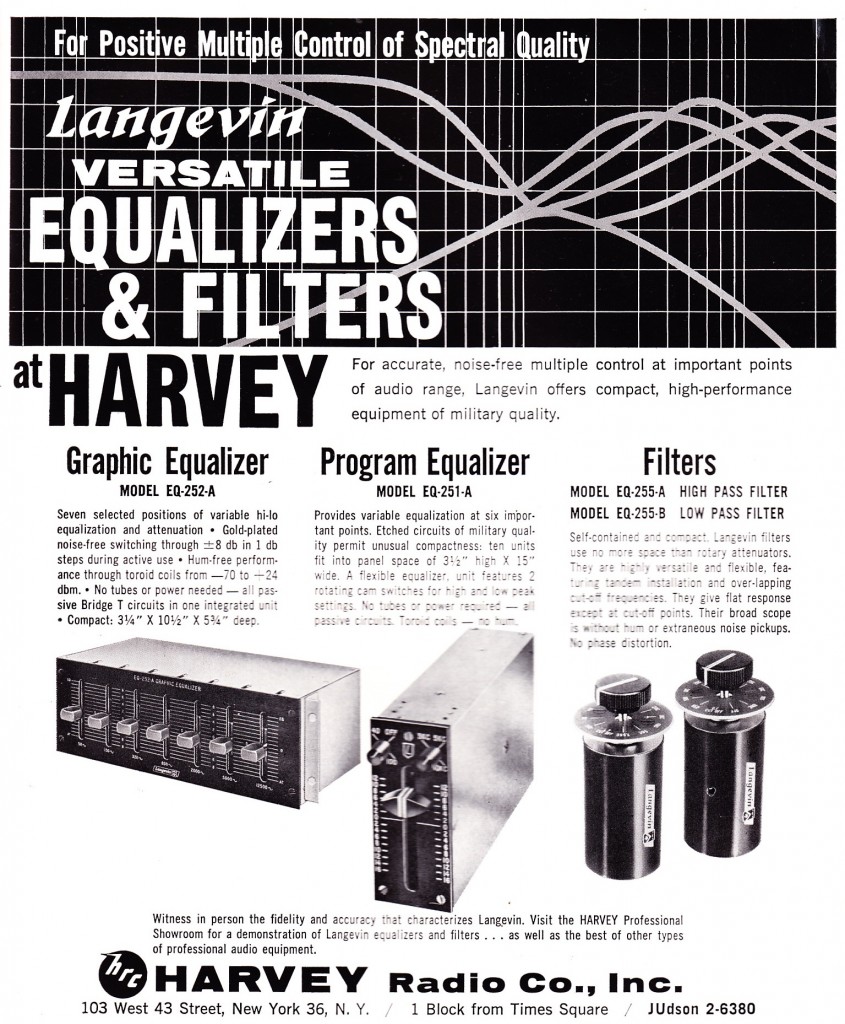 Ok so these are not outboard so much as inboard but you get the connection. The Langevin EQ-252A, EQ-251-A, and EQ-255 filters of 1961.
Ok so these are not outboard so much as inboard but you get the connection. The Langevin EQ-252A, EQ-251-A, and EQ-255 filters of 1961.
********
***
*
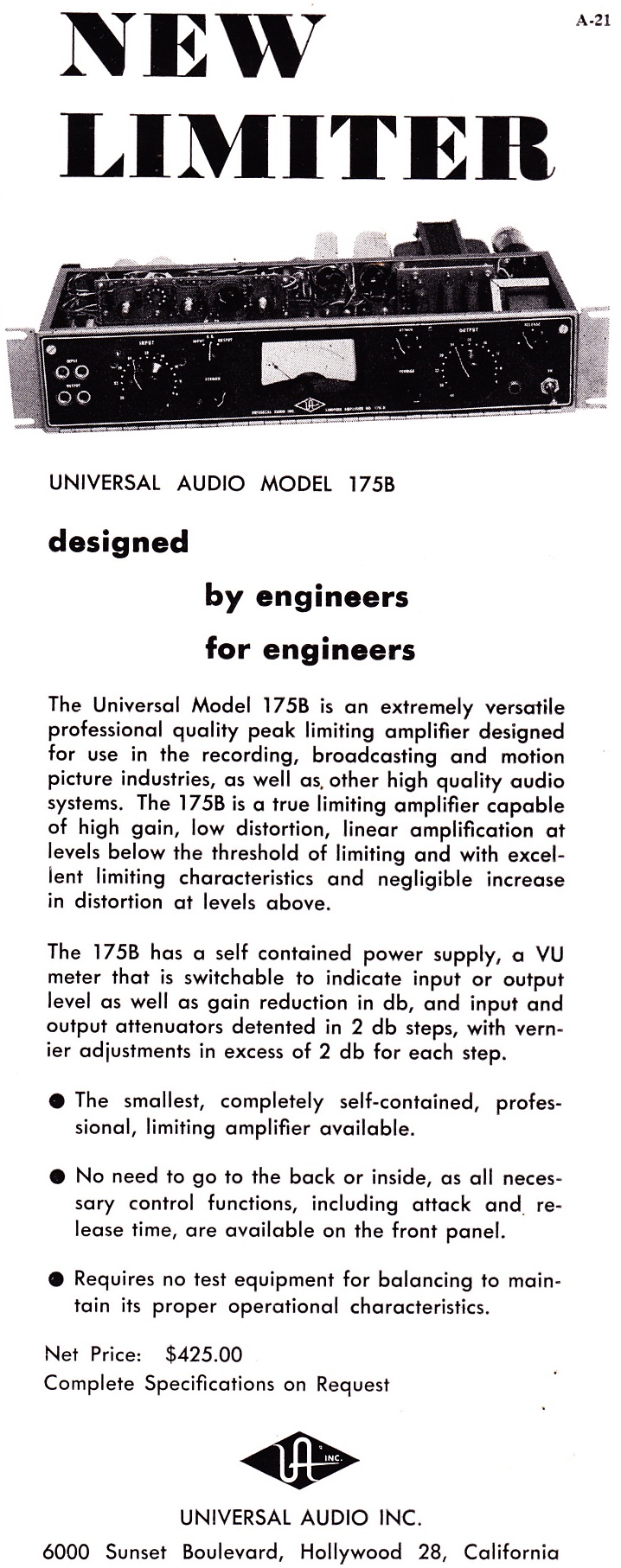 Above: the Universal Audio 175B limiter is announced. The 175B is quite similar in operational principle to the Altec 436/8 and the Gates Sta-Level but the UA is far more sophisticated. Just a really smartly designed piece of AFAIK, it was sold like shown, with no top cover. gear. Retro Instruments currently makes a reissue of this classic piece (but with a top cover).
Above: the Universal Audio 175B limiter is announced. The 175B is quite similar in operational principle to the Altec 436/8 and the Gates Sta-Level but the UA is far more sophisticated. Just a really smartly designed piece of AFAIK, it was sold like shown, with no top cover. gear. Retro Instruments currently makes a reissue of this classic piece (but with a top cover).
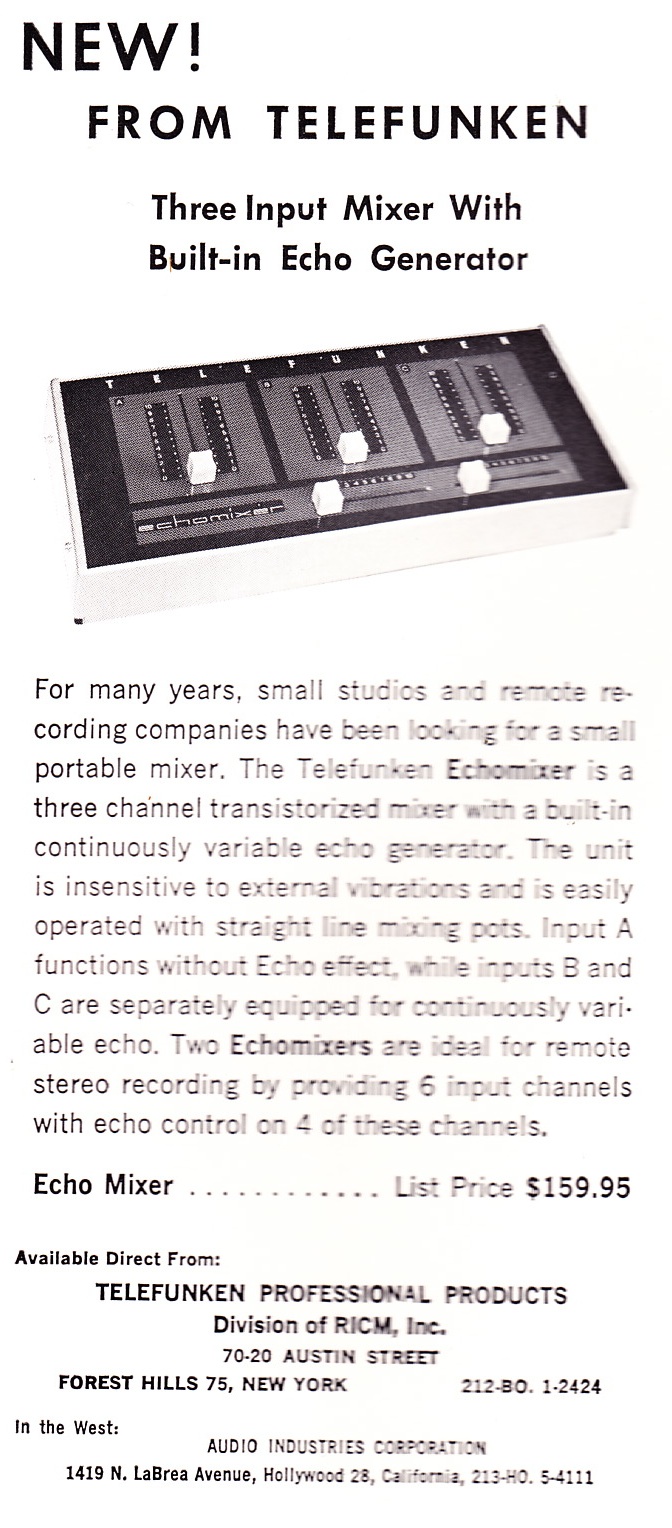 Above: an inexpensive studio echo unit of the early 1960s: the Telefunken Echo Mixer. It is a spring-reverb unit. Click this link for an audio demo. Apparently used by Klaus Schulze on his “Irrlicht,” which is one of my favorite records.
Above: an inexpensive studio echo unit of the early 1960s: the Telefunken Echo Mixer. It is a spring-reverb unit. Click this link for an audio demo. Apparently used by Klaus Schulze on his “Irrlicht,” which is one of my favorite records.

